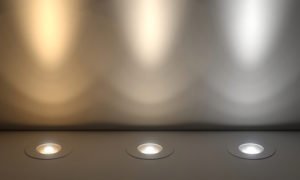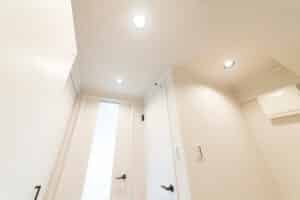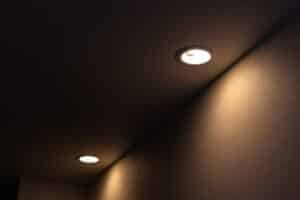
LED Downlights vs Halogen Lights
When it comes to wattage, you want your lights to be energy-saving but still produce a high beam. As such, we recommend using LED downlights. The average 10 watt LED downlight produces a beam twice as bright as halogen lights that use up to 55 watts. This makes LED downlights the best option when it comes to energy saving.
Colour Temperature

Did you know there were different colour temperatures? These range from warm lights to bright, cool white. Generally, we suggest bright, cool white for task rooms like kitchens and laundries. But in more intimate spaces, like bedrooms and studies, warmer downlights make a better option. If you’re looking for a good, all-around light temperature, 4000K lights are a good all-rounder. It provides a cool, clean look but still provides a warmth that doesn’t overpower the eyes.
Lumens
Once upon a time, you could look at the wattage on a light bulb pack and work out the brightness of the light. While this is still the case for halogen and fluorescent lights, LEDs are different. Because the wattage of LEDs is generally low due to their energy-saving technology, we now use lumens to understand the brightness of LEDs. Lumens measure the total amount of visible light from the bulb. The higher the lumens, the brighter the light.
Downlight Beam Angle

Beam angle refers to the amount of light that spreads from the downlight. It is generally measured in degrees. Usually, most downlights will have a beam angle of 45° due to being recessed. A regular bulb, however, will have a 360° beam angle. For downlights, we suggest choosing lights with a wider beam angle, around 60°. This allows a soft, diffuse light for rooms like bedrooms or lounge rooms. For task spaces, however, we recommend a narrower beam, around 25°, to give a concentrated light to illuminate surfaces and smaller details in the room.
Colour Rendering Index
Colour Rendering Index or CRI refers to the light source’s ability to reveal the colour of objects faithfully in comparison with natural light. The index measures from 0 to 100, with a perfect 100 meaning that colours will appear under the light the same as they would under natural light. For homes, a CRI between 80 to 90 is perfect for accurate colour rendering.
LED Downlight Lifespans
The lifespan of your lights depends on the type of light you invest in. halogen downlights last for around 2,000 hours on average. This means most people are replacing their halogen globes within 12-18 months. LED downlights, on the other hand, have a lifespan of around 50,000 hours which relates to around 27 years of use, even if it is on for 5 hours a day. This makes them more cost-effective to run.
Insulation Contact Rating

The insulation contact rating or IC rating tells you whether a downlight is suitable to come in contact with your home’s building insulation. Lights with an IC rating can come in direct contact with building insulation and timbers without being a fire hazard. An important thing to remember when choosing IC-rated lights is that they have a warranty for a minimum of 3 years. And you should never buy lights that don’t have an IC rating if you’re placing them near timber or insulation.
Looking for the perfect LED downlight for your home? Explore our range of LED downlights today. Martec has a wide range of lights, ideal for your home or office. And our talented team can help you find the perfect fit for your home. Check out the range or contact us today!